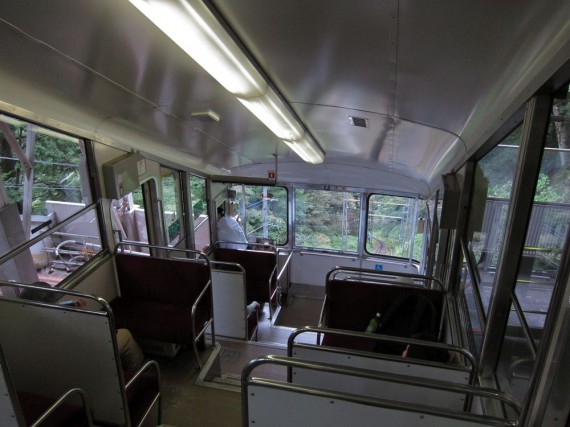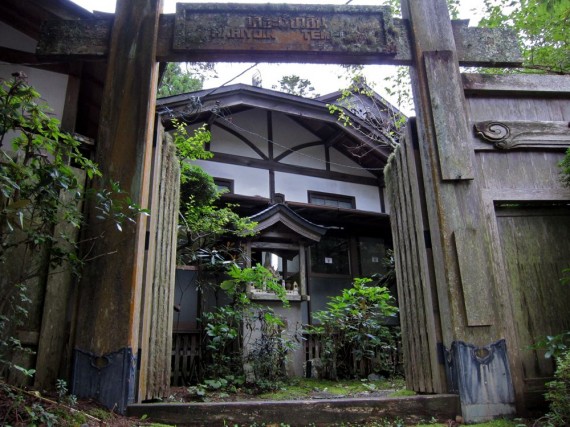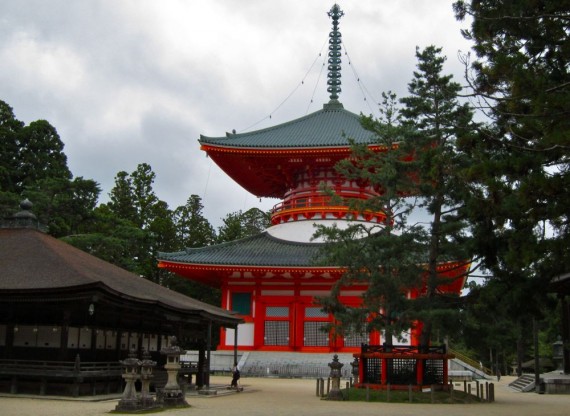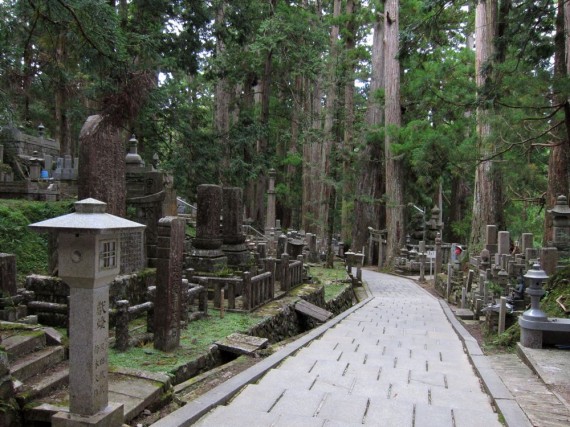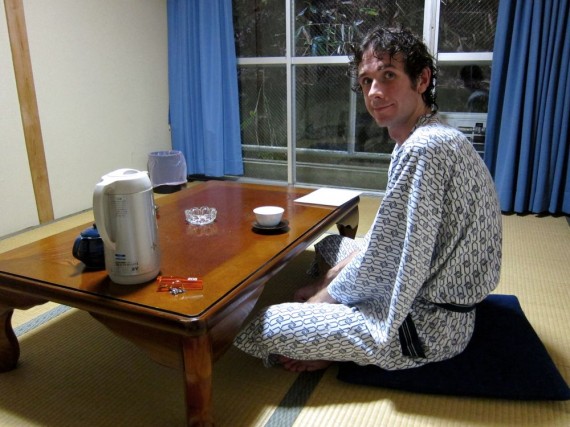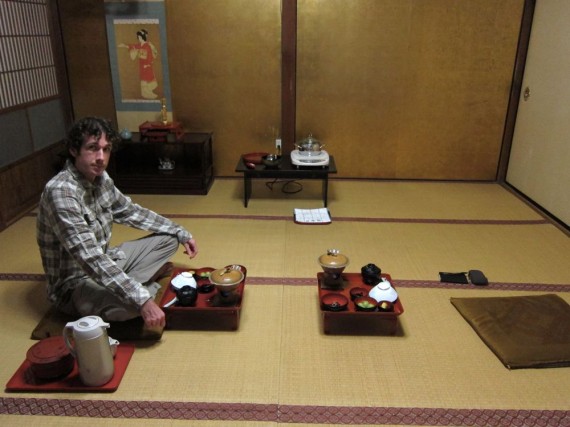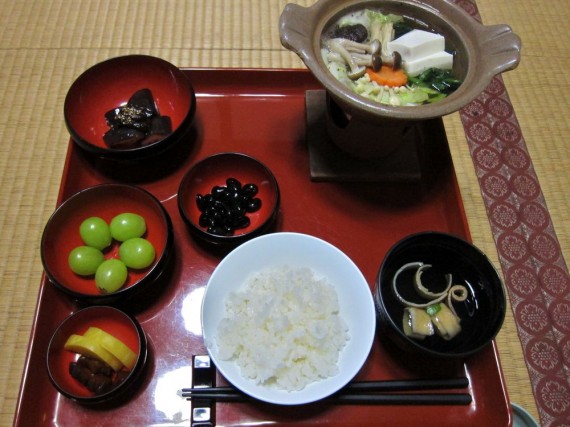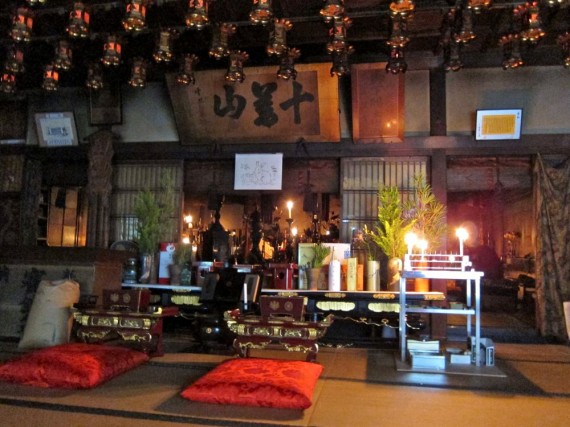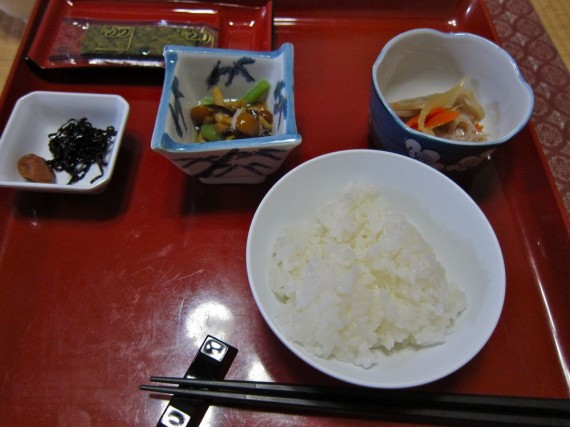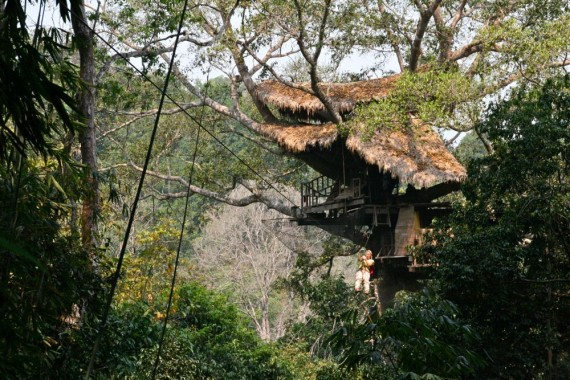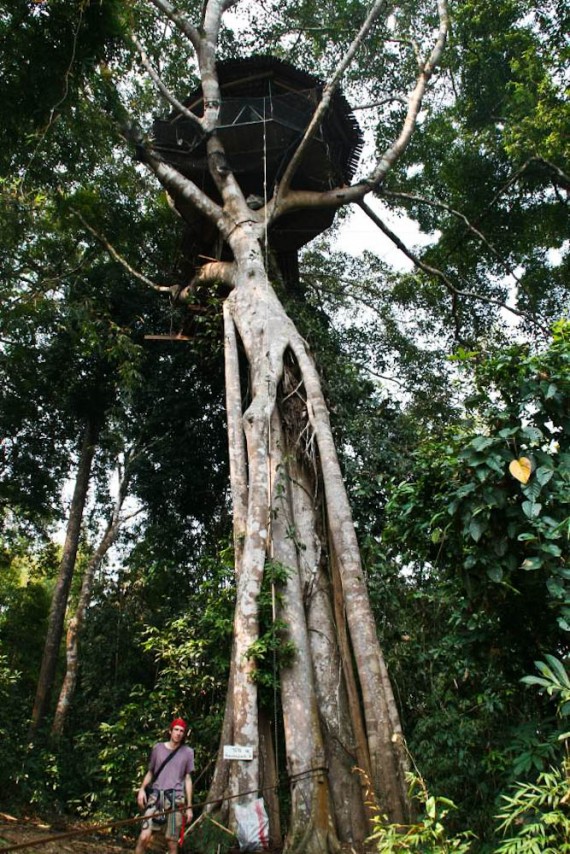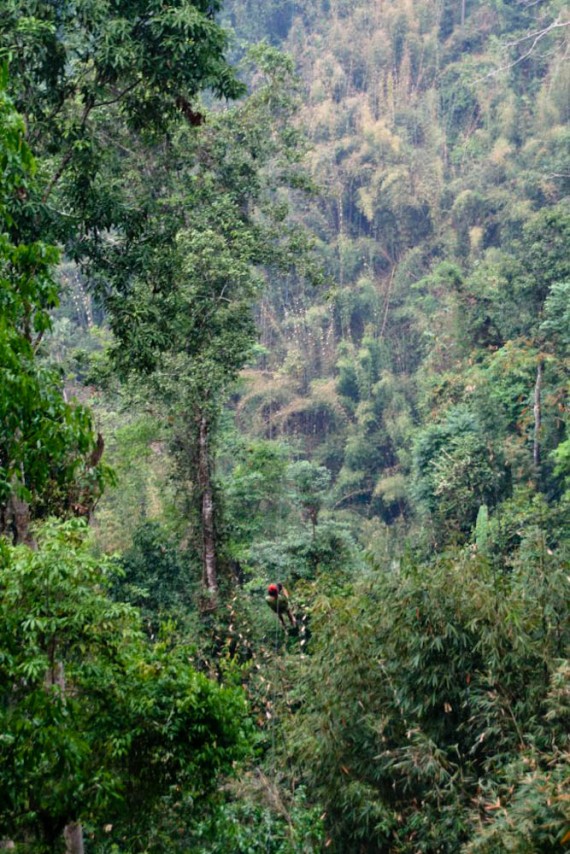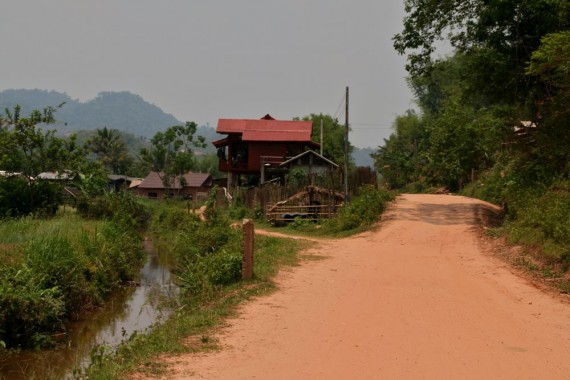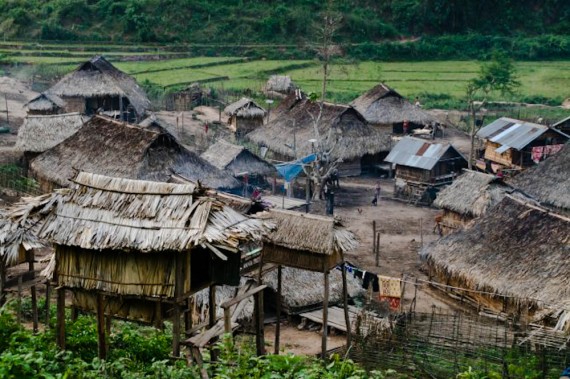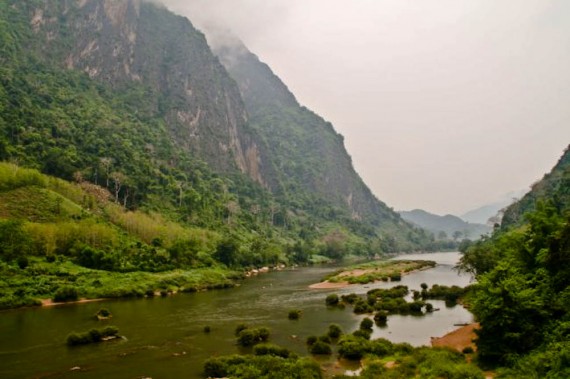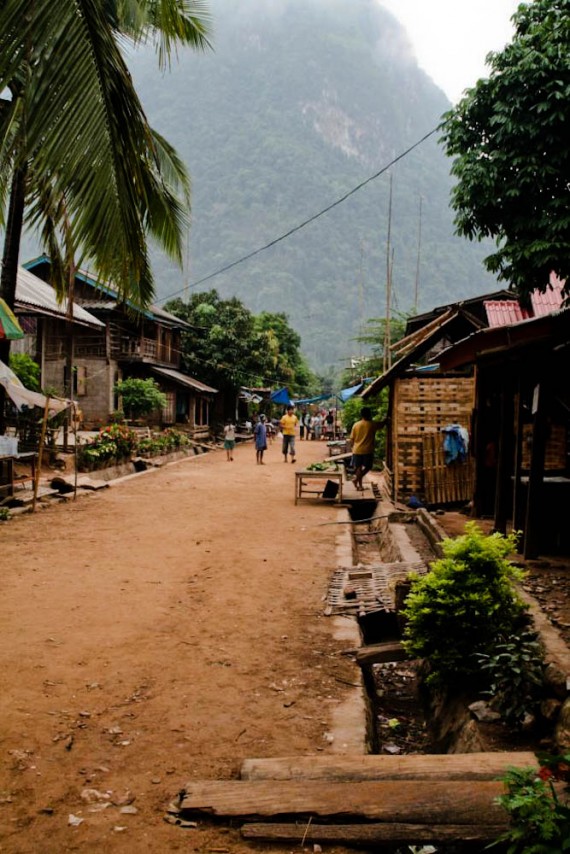It took eight modes of transport to get to Koya-san from Kyoto: metro, bullet train, metro, train, bus, train, cable car, bus. In any other country the journey would have taken all day, but despite a damaged train track from the recent typhoon, in Japan it took less than four hours and the transfers were seamless.
We visited Koya-san, the respectful name given to Mount Koya, to experience traditional Japan. The secluded temple town is located high up in the forest-covered mountains of Kansai and was founded 1200 years ago by Kobo Daishi to spread his teachings about Shingon Buddhism. One temple has grown to over one hundred and the town is now an important Buddhist centre. It is also one of the best places to stay in shukubo, traditional temple lodging to get a taste of life as a monk including sampling shojin ryori, vegetarian monk’s cuisine and rising early to participate in the daily chanting and meditation ceremony.
After our series of efficient trains and buses we transferred to the cable car which climbed through the forest at a precariously steep angle up to an elevation of 800 metres. The town’s bus was waiting for us and dropped us on a ghostly quiet street lined with temples – we had no idea which was ours. Feeling hopeful we approached the entrance of one of the attractive temples of shiny dark wood. A novice monk in flowing robes came to the door and we asked for Haryo-in, the temple we had booked for the night. He put on his wooden geta and indicated for us to follow as he clip-clopped his way across the road.
Oh. That’s Haryo-in? We stared at the shabby entrance way, decidedly less graceful than its lovely neighbours. You see, accommodation in Japan is expensive, and most of the temple stays cost about 23,000 yen (US$295) per couple per night whereas Haryo-in is a bargain 13,650 yen (US$175). Now we knew why.
As we walked through the cobweb-draped gateway into the overrun garden (very un-Japanese) a snake slithered in front of us. This didn’t seem a good omen.
It was eerily quiet but a Japanese lady did respond to our ringing of the bell and seemed to be expecting us. She spoke some English which made things easier as she took our bags and said we could come back to check in at 4pm. She also gave us an information sheet with the temple’s schedule. We had to be sure to check-in before 5pm as dinner was served at 5.30pm. The communal bath was open from 4-8pm, the temple doors would close at 9pm and it’d be lights out at 10pm. An early night was probably a good idea as the morning service was at 6.30am before breakfast the next day.
Exploring Koya-san
With five hours before check-in we set off to explore the strangely quiet town. After a vegetarian lunch at Bon On Shya café we strolled through the town, past shops selling sweet mochi and koya-dofu, a freeze dried tofu that comes from the area. Koya-san is surrounded by hills and the air is a little cooler than in Osaka – a blessing in summer. There are many temples you can visit but we focused on the two main areas – the Garan sacred precinct and the Okunoin Cemetery.
We had spent more than three weeks exploring Kyoto’s temples and shrines but the original temple complex at Koya-san, the Garan, was still impressive. Daito the humongous red pagoda dominated the smaller buildings around the peaceful complex. We watched a monk ringing a large bell over and over.
Koya-san’s main attraction is the huge and impressive Okunoin Cemetery. Thousands of tombs and Buddhist statues are found beneath giant cedar trees in an atmospheric forest. As we wandered along the quiet paths we came across a few odd “attractions”. One small wooden hut housed a large rock, which you try to lift through a window. If it’s heavy it means you are sinful. It was heavy.
In another spot we were instructed to look down a well. If we couldn’t see our reflection then we’d die within three years. We were a little nervous as we peered into the murky water far down below but thankfully saw our reflections.
Koya-san is small so it didn’t take us long to walk from the cemetery which is located at one end of town to the Daimon entrance gate on the other side. We then wondered how we’d fill up the rest of the time before check-in. It didn’t help when it began to rain.
The Trauma of Japanese Communal Baths
We rarely saw foreigners while we were in Kyoto, so were surprised to see about eight or so while walking around this small town. As we passed we analysed them for the likelihood that they’d be staying in our budget temple lodging. Our first communal bathing experience was looming and it freaked us out. Bathing naked with tourists that we’d then be chatting to over dinner just felt too weird. We devised a strategy – we’d take our bath early and hopefully have it to ourselves.
At 4pm sharp we checked in, donned our yukatas (cotton kimono) and hurried downstairs to the communal baths –one each for men and women. We had read up on bathing etiquette so knew the drill. You leave your clothes (yes, all of them) in a tray in an outer room and walk unadorned into the bathing area. Next you wash your body and hair at one of the showers (soap and shampoo are provided) before getting into the bath.
It was steaming hot and deliciously relaxing – for a moment. We couldn’t help worrying that someone could come in at any moment. We are so used to bathing being a private activity that the idea of sharing a bath with a stranger was difficult to get used to. The bath could fit four people but it would be a little close for comfort. We managed to endure the heat and nerves for as long as we could before getting out without meeting anyone else. Success!
We needn’t have worried. It turned out we were the only guests and we only saw one monk for the rest of the night. We had the temple to ourselves.
Our Temple Accommodation
Our biggest challenge over with we headed back to our room. The temple may not be as pristine as most we’ve visited but the main part does have character with a maze of corridors overlooking cute inner rock gardens. It’s not often that you return from a bath and meet a serene monk in saffron robes lighting incense and ringing bells.
The accommodation is in a rather unattractive concrete section with a long corridor of rooms and a row of sinks and toilets at one end. Our six tatami mat room wasn’t fancy but was better than we expected. It was very Zen, empty except for a low table, two cushions and a sacred alcove with a Buddhist statue, scroll and a place to light incense. Unlike some of the more fancy temples we didn’t get a garden view – our window looked over an iron railing and greenery covered embankment. Although the room wasn’t beautiful it was our first night staying in a temple so we were excited by the new experience. In our comfortable yukatas we sat on cushions to drink the green tea we’d been left and waited for the dinner bell.
Temple Dining
The dining room was another minimalist tatami space overlooking the inner garden. Our meal was waiting for us on red lacquer trays. The monk we’d seen earlier served us rice without saying a word and left us alone to eat.
We found every Japanese meal an adventure and this was no exception as we ate our way through the simple but fresh and tasty meal of rice, miso soup, Yudofu a mushroom and tofu hotpot, pickles, eggplant in a miso dressing, sweet black beans, and grapes. The meal didn’t quite compare to the complex flavours of the shojin ryorivegetarian meals we’d had in Kyoto, but this is probably due to the lower price we were paying. Other temples may have more extravagant feasts.
Koya-san shuts down at night so there was nothing left to do but return to our room and set up our bed for the night. In traditional Japanese accommodation you sleep on futons – thin mattresses that are stored away during the day and brought out to sleep on. We stacked up a few for added comfort and added the straw-filled pillows.
Morning Chanting
In the morning we were woken at 6am by a series of gongs and made it down to the main temple room for the morning ceremony. We had expected more monks but it was just us and the monk we’d met the previous day, although we still hadn’t spoken. We sat on the floor in a large tatami room facing into a neighbouring room which looked like a dusty antique shop full of golden Buddha statues and tall candle stands. The monk had a limp and it took him some time to move around the room lighting all of the candles.
When he was finished he sat on a large cushion amongst the Buddhas, facing away from us, and began to chant in a deep voice. Of course we couldn’t understand any of it but could follow the intonation. Sometimes he slowed to a conversational pace, sometimes becoming louder and more impassioned. His chanting was punctuated by hitting gongs, ringing hand bells and blowing into a wind instrument. The momentum built and things became even more exciting when he lit up a fire in front of him.
Another elderly monk entered the ceremonial room about half way through. Tardiness didn’t seem in keeping with the temple ethic, but this was an unusual temple. He sat quietly at one end, sometimes muttering to himself.
When the ceremony came to an end the elderly monk disappeared and the limping monk entered our room. Should we leave? Is there more? We waited, unsure.
The monk surprised us by talking for the first time. We had assumed he couldn’t speak English but although we struggled to follow everything he said he spoke it quite well. He told us the story behind his limp, how he had an aneurysm 14 years ago leaving him paralysed in one side and was told he’d never walk again. With determination he managed to though. I’m sure there is more to the story but unfortunately we couldn’t understand it all.
Breakfast was waiting for us in the dining room – a traditional meal of rice, miso soup, two types of seaweed, pickled plum, cold mushrooms in a marinade (surprisingly delicious) and cold lotus root and carrot.
It was still early but there wasn’t much to wait around for so we said goodbye to the monk and went on our way. It was a fascinating experience and one we’d recommend. If you can afford the more upmarket temples though you might want to splurge.

